
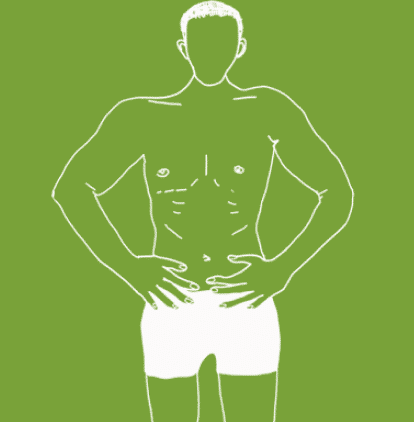
Signs and Symptoms Include:
- Painful sensations like aching, itching, or burning around the penis, scrotum, anus, or perineum
- Aggravated pain during physical activities, prolonged sitting, or when wearing snug clothing
- Urinary symptoms such as increased urgency, slower stream, or hesitancy
- Pain linked to ejaculation, affecting different parts of the pelvic region
- Erectile function may be diminished, including weakened ejaculation
- GI troubles such as constipation, gassiness, or bloating
- Gastrointestinal pain that flares up unexpectedly or in response to exercise or sexual activity
- Episodes of pain may be sporadic or ongoing
If you live in San Diego and these symptoms sound familiar, know that physical and occupational therapy could offer the targeted, long-lasting solution you need.
Signs and Symptoms Include:
- Painful sensations like aching, itching, or burning around the penis, scrotum, anus, or perineum
- Aggravated pain during physical activities, prolonged sitting, or when wearing snug clothing
- Urinary symptoms such as increased urgency, slower stream, or hesitancy
- Pain linked to ejaculation, affecting different parts of the pelvic region
- Erectile function may be diminished, including weakened ejaculation
- GI troubles such as constipation, gassiness, or bloating
- Gastrointestinal pain that flares up unexpectedly or in response to exercise or sexual activity
- Episodes of pain may be sporadic or ongoing
If you live in San Diego and these symptoms sound familiar, know that physical and occupational therapy could offer the targeted, long-lasting solution you need.

Associated Diagnoses
Chronic Pelvic Pain Syndrome/Male Pelvic Pain, Chronic Nonbacterial Prostatitis, Pudendal Neuralgia, Hard Flaccid Syndrome and Interstitial Cystitis/Painful Bladder Syndrome are all pain syndromes that cause pelvic pain due to pelvic floor dysfunction.
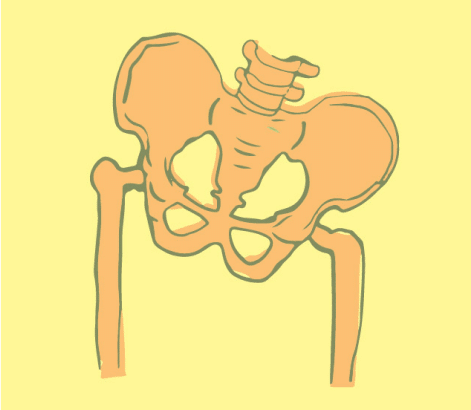
Associated Diagnoses
Chronic Pelvic Pain Syndrome/Male Pelvic Pain, Chronic Nonbacterial Prostatitis, Pudendal Neuralgia, Hard Flaccid Syndrome and Interstitial Cystitis/Painful Bladder Syndrome are all pain syndromes that cause pelvic pain due to pelvic floor dysfunction.

- Surgical trauma (vasectomy, benign prostatic hyperplasia (BPH) interventions, prostatectomy)
- Orthopedic injuries or other traumas (spine, hip, knee, and/or ankle injuries/pathology, accidents)
- Biomechanical or structural dysfunction (hip dysfunction, piriformis syndrome, scoliosis, leg length discrepancy)
- Excessive exercise or changes to exercise routine
- Excessive sitting
- Chronic constipation and straining
- Jelqing and/or attempts at gential enhancement or foreskin regeneration
- In rare cases, bladder, prostate, or sexually transmitted infections after successful resolution of infection
- The majority of men with pelvic pain, with or without urinary or bowel complaints, have pelvic floor dysfunction

Causes of Pelvic Pain
- Surgical trauma (vasectomy, benign prostatic hyperplasia (BPH) interventions, prostatectomy)
- Orthopedic injuries or other traumas (spine, hip, knee, and/or ankle injuries/pathology, accidents)
- Biomechanical or structural dysfunction (hip dysfunction, piriformis syndrome, scoliosis, leg length discrepancy)
- Excessive exercise or changes to exercise routine
- Excessive sitting
- Chronic constipation and straining
- Jelqing and/or attempts at gential enhancement or foreskin regeneration
- In rare cases, bladder, prostate, or sexually transmitted infections after successful resolution of infection
- The majority of men with pelvic pain, with or without urinary or bowel complaints, have pelvic floor dysfunction
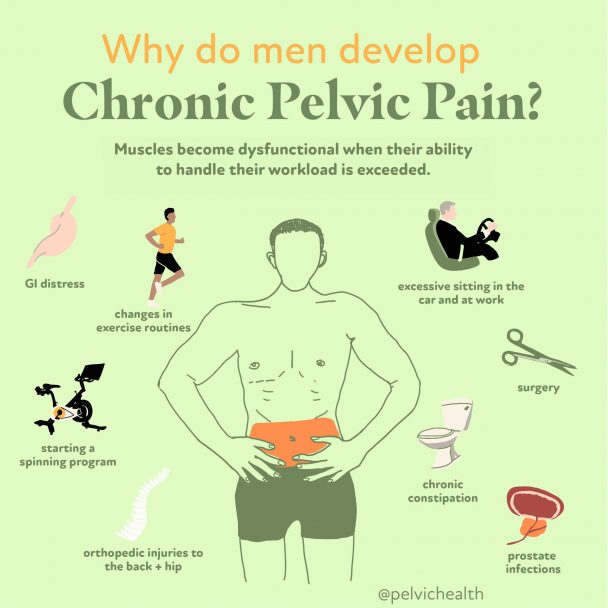
Diagnostic Challenges
It can take an astonishing seven years for men with pelvic pain to get a diagnosis that reflects the true root of their condition. This is primarily because the symptoms mimic common urological and infectious issues like prostatitis or STIs. As a result, patients are frequently given antibiotics without proper diagnostic testing, leading to continued pain and confusion. Moreover, many healthcare providers aren’t familiar with the fact that pelvic floor dysfunction can impact men. Compounding the problem is that pelvic floor therapy is often viewed as a women-only field. That’s not the case at PHRC, where our team treats a high volume of male patients and brings specialized experience to help men feel understood and properly cared for.
In cases of male pelvic pain, a misdiagnosis of “prostatitis” is all too frequent, often resulting in the prescription of antibiotics even when no infection is present. Evidence shows that more than 90% of men who experience pelvic and urinary tract-related symptoms are not dealing with a prostate infection. Instead, the actual diagnosis typically lies within Chronic Pelvic Pain Syndrome (CPPS), specifically within the National Institutes of Health’s categories IIIa or IIIb.
The NIH has established the following categories for prostatitis syndromes:
Category I: Acute bacterial prostatitis – presents with sudden, severe symptoms and is accompanied by a bacterial infection and systemic illness.
Category II: Chronic bacterial prostatitis – distinguished by repeated urinary tract infections due to a long-standing bacterial presence in the prostate.
Category IIIa: Inflammatory CPPS – associated with the detection of white blood cells in semen or other prostatic secretions.
Category IIIb: Non-inflammatory CPPS – has similar symptoms to IIIa but lacks any observable inflammatory markers in bodily fluids.
Category IV: Asymptomatic inflammatory prostatitis – occurs when inflammation is present, but the patient experiences no symptoms.
Diagnostic Challenges
It can take an astonishing seven years for men with pelvic pain to get a diagnosis that reflects the true root of their condition. This is primarily because the symptoms mimic common urological and infectious issues like prostatitis or STIs. As a result, patients are frequently given antibiotics without proper diagnostic testing, leading to continued pain and confusion. Moreover, many healthcare providers aren’t familiar with the fact that pelvic floor dysfunction can impact men. Compounding the problem is that pelvic floor therapy is often viewed as a women-only field. That’s not the case at PHRC, where our team treats a high volume of male patients and brings specialized experience to help men feel understood and properly cared for.
In cases of male pelvic pain, a misdiagnosis of “prostatitis” is all too frequent, often resulting in the prescription of antibiotics even when no infection is present. Evidence shows that more than 90% of men who experience pelvic and urinary tract-related symptoms are not dealing with a prostate infection. Instead, the actual diagnosis typically lies within Chronic Pelvic Pain Syndrome (CPPS), specifically within the National Institutes of Health’s categories IIIa or IIIb.
The NIH has established the following categories for prostatitis syndromes:
Category I: Acute bacterial prostatitis – presents with sudden, severe symptoms and is accompanied by a bacterial infection and systemic illness.
Category II: Chronic bacterial prostatitis – distinguished by repeated urinary tract infections due to a long-standing bacterial presence in the prostate.
Category IIIa: Inflammatory CPPS – associated with the detection of white blood cells in semen or other prostatic secretions.
Category IIIb: Non-inflammatory CPPS – has similar symptoms to IIIa but lacks any observable inflammatory markers in bodily fluids.
Category IV: Asymptomatic inflammatory prostatitis – occurs when inflammation is present, but the patient experiences no symptoms.
Treatment:
How We Can Help You
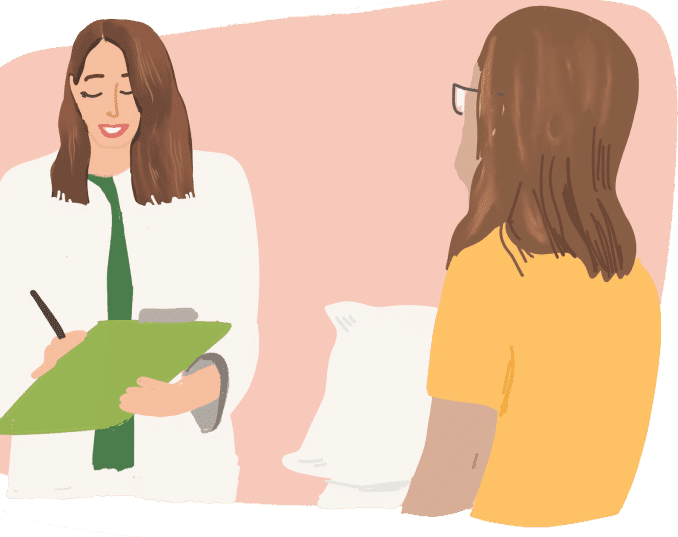
If you’re in San Diego and struggling with pelvic pain, a consultation with a pelvic floor physical and occupational therapists could be exactly what you need. Your first appointment will involve a compassionate review of your medical background, previous diagnoses, treatments you’ve tried, and a discussion of the pain you’re living with. We’re well aware that many San Diego patients arrive at our office feeling hopeless after being misunderstood or misdiagnosed.
Next, the therapist conducts a full physical examination—assessing your pelvic floor muscles, surrounding tissues, joint function, nerve activity, and overall body mechanics. Once this evaluation is complete, you’ll receive a detailed explanation of the root causes of your pain and a comprehensive plan to overcome it. Therapy in San Diego generally involves one to two sessions per week for approximately 12 weeks, supported by an individualized home program. Your PT will work alongside any other healthcare professionals you’re seeing to ensure a unified approach. We’re here to support your recovery every step of the way.
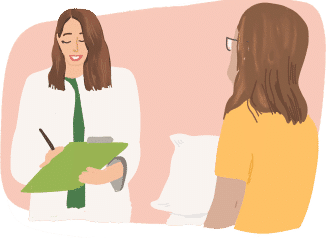
Treatment:
How We Can Help You
If you’re in San Diego and struggling with pelvic pain, a consultation with a pelvic floor physical and occupational therapists could be exactly what you need. Your first appointment will involve a compassionate review of your medical background, previous diagnoses, treatments you’ve tried, and a discussion of the pain you’re living with. We’re well aware that many San Diego patients arrive at our office feeling hopeless after being misunderstood or misdiagnosed.
Next, the therapist conducts a full physical examination—assessing your pelvic floor muscles, surrounding tissues, joint function, nerve activity, and overall body mechanics. Once this evaluation is complete, you’ll receive a detailed explanation of the root causes of your pain and a comprehensive plan to overcome it. Therapy in San Diego generally involves one to two sessions per week for approximately 12 weeks, supported by an individualized home program. Your PT will work alongside any other healthcare professionals you’re seeing to ensure a unified approach. We’re here to support your recovery every step of the way.
How Can We Help You?
We welcome your questions and comments—please fill out the form below to connect with us. An email address is required to ensure we can respond. Your personal information will be handled with care and kept entirely confidential.

Join The Newsletter. Win a copy of our book, “Pelvic Pain Explained!”
We love getting to know our website visitors. Please tell us a little bit about yourself and get the latest info via PHRC e-newsletter!
*Subscribers automatically eligible to win our book, “Pelvic Pain Explained.”
At its essence, Pelvic Pain Explained offers a comprehensive look into the onset of pelvic pain, the diagnostic confusion that often surrounds it, and the frustration patients and providers alike experience in searching for effective treatment. The book also touches on the wide-reaching emotional and social impacts of living with a condition that’s invisible to the outside world, making its challenges even more isolating.


